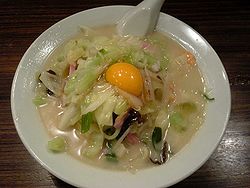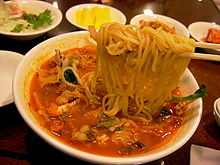
Champon
Encyclopedia

Noodle
The noodle is a type of food, made from any of a variety of doughs, formed into long thin ribbons, strips, curly-cues, waves, helices, pipes, tubes, strings, or other various shapes, sometimes folded. They are usually cooked in a mixture of boiling water and/or oil. Depending upon the type, noodles...
dish that is a regional cuisine
Regional cuisine
Regional cuisine can be defined as cuisine based upon global, national, state or local regions. Regional cuisines may vary based upon food availability and trade, varying climates, cooking traditions and practices, and cultural differences...
of Nagasaki
Nagasaki
is the capital and the largest city of Nagasaki Prefecture on the island of Kyushu in Japan. Nagasaki was founded by the Portuguese in the second half of the 16th century on the site of a small fishing village, formerly part of Nishisonogi District...
, Japan. Due to the inspiration from Chinese cuisine, it is also a form of Japanese Chinese cuisine
Japanese Chinese cuisine
Japanese Chinese cuisine is a unique style of Chinese cuisine served by Chinese restaurants in Japan. Many of these restaurants are Japanese-owned, though there are some which are operated by overseas Chinese...
. Champon is made by frying pork, seafood and vegetables with lard; a soup made with chicken and pig bones is added. A ramen
Ramen
is a Japanese noodle dish. It consists of Chinese-style wheat noodles served in a meat- or fish-based broth, often flavored with soy sauce or miso, and uses toppings such as , , kamaboko, green onions, and occasionally corn...
noodle made especially for champon is added and then boiled. Unlike other ramen dishes, only one pan is needed as the noodle is boiled in the soup. Depending on the season and the situation, ingredients differ. Hence the taste and style may depend on the location and time of year.
History
Champon was first served by , a Chinese restaurant in NagasakiNagasaki
is the capital and the largest city of Nagasaki Prefecture on the island of Kyushu in Japan. Nagasaki was founded by the Portuguese in the second half of the 16th century on the site of a small fishing village, formerly part of Nishisonogi District...
. According to the restaurant, it was based on a dish in Fujian cuisine
Fujian cuisine
Fujian cuisine is one of the native Chinese cuisines derived from the native cooking style of the province of Fujian, China. Fujian style cuisine is known to be light but flavourful, soft, and tender, with particular emphasis on umami taste, known in Chinese cooking as "xiānwèi" , as well as...
, In the middle of Meiji period
Meiji period
The , also known as the Meiji era, is a Japanese era which extended from September 1868 through July 1912. This period represents the first half of the Empire of Japan.- Meiji Restoration and the emperor :...
, the owner saw a need for a cheap, but filling, meal that fitted the taste of hundreds of Chinese students who came to Japan for schooling opportunities. Nowadays Champon is a popular specialty food (or meibutsu
Meibutsu
Meibutsu is a Japanese term for famous products associated with particular regions. Meibutsu are usually items of Japanese regional cuisine, although the category includes local handicrafts. Meibutsu typically have a traditional character, although contemporary products may qualify as meibutsu...
) of Nagasaki and is a one of most popular Koreanized Chinese foods
Korean Chinese cuisine
Korean Chinese cuisine is derived from traditional Chinese cuisine but has been influenced by local ingredients in Korea. Due to geographical proximity, most Korean-Chinese dishes are derived from Northern styles of Chinese cuisine such as Beijing and Shandong cuisine. However, some have regarded...
in Korea.
Etymology
The word champon may also be used for many kinds of random acts where things are mixed. It can also be used to describe the practice of mixing different types of alcohol on a single occasion. In Korea, jjambbong (짬뽕) is a slang which means mix-up.Korean champon

Korean Chinese cuisine
Korean Chinese cuisine is derived from traditional Chinese cuisine but has been influenced by local ingredients in Korea. Due to geographical proximity, most Korean-Chinese dishes are derived from Northern styles of Chinese cuisine such as Beijing and Shandong cuisine. However, some have regarded...
there is a similar dish called jjambbong (짬뽕). The Shandong
Shandong
' is a Province located on the eastern coast of the People's Republic of China. Shandong has played a major role in Chinese history from the beginning of Chinese civilization along the lower reaches of the Yellow River and served as a pivotal cultural and religious site for Taoism, Chinese...
version tends to be the most spicy.
In the late 19th century and early 20th century, many Chinese emigrated to Japan and Korea. There was a regular sea route between Nagasaki and Jemulpo via Busan
Busan
Busan , formerly spelled Pusan is South Korea's second largest metropolis after Seoul, with a population of around 3.6 million. The Metropolitan area population is 4,399,515 as of 2010. It is the largest port city in South Korea and the fifth largest port in the world...
. Many of the Chinese immigrants opened restaurants and created new versions of their home food. In Korea, it became spicier by using red pepper, chili oil
Chili oil
Chili oil is a condiment made from vegetable oil that has been infused with dried chili peppers and sometimes also additional ingredients. It is commonly used in Chinese cuisine, East and Southeast Asia and elsewhere. Particularly popular in Sichuan cuisine, it is used as an ingredient in cooked...
, and doubanjiang
Doubanjiang
Doubanjiang is a spicy, salty paste made from fermented broad beans, soybeans, salt, rice, and various spices. Doubanjiang exists in plain and spicy versions, with the latter containing red chili peppers and called la doubanjiang .It is used particularly in Sichuan cuisine, and in fact, the people...
(Chinese red pepper paste). Today, it is a popular dish that is common in Korea and in Korean neighbourhoods around the world.

